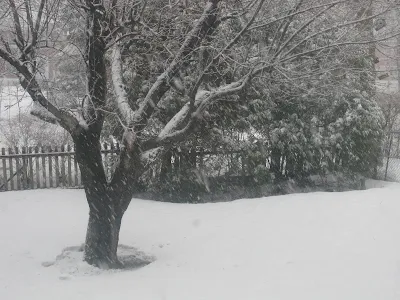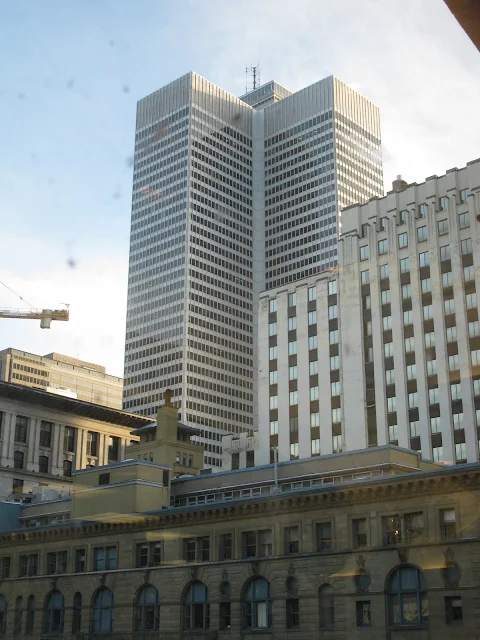Thursday, April 14, 2011
Monday, April 11, 2011
Thursday, April 7, 2011
Sunday, April 3, 2011
A walk in NDG (six)
In these "walks" in NDG, I have wanted to show some of the expressions of spirituality in this neighbourhood. I've noted before that Quebec is the most secular and probably anti-religious place in North America, but expressions of Spirit are still present. Spirituality is a part of the human psyche and, basically, you can try to repress it, you can make it unpopular and not politically correct to say you pray or you believe in God, but Spirit, God, and prayer are a part of the psyche, a part of human consciousness, and they cannot be denied or repressed for long. As an example of this, consider the emergence of the orthodox church in present-day Russia. Even after seventy years of official atheism people needed religion, not the substitute of dialectical materialism and Communism . . . In this photograph, someone has placed a cross over a side door, beneath a pizza parlour, just off Fielding near Walkely Avenue in Notre Dame de Grace, Montreal.
Note: as of 04 July 2023 I am not as optimistic as I was when I wrote this. Quebec was never secular until around 1960 with the Quiet Revolution, before this it was in the grip of the Roman Catholic Church; today, this very claim to secularism is being as an excuse to deny religious groups their freedom to express their religion, as per Bill 21 and the restriction of wearing religious garb when employed by the massive civil service here.
Friday, April 1, 2011
Thursday, March 31, 2011
A walk in NDG (five)
Here we are on the Loyola Campus of Concordia University, a statue of Mary near the Psychology Department.
Wednesday, March 30, 2011
Review of James Hollis's On this Journey ...
On This Journey We Call Our Life: Living the Questions,
Review by Stephen Morrissey
James Hollis's latest Inner City book, On This Journey We Call Our Life, is directed to those of us in the second half of life. On the surface, the inner journey is from psychic fragmentation to psychic wholeness, but is it really? Hollis presents the question, "What does the soul ask of me?" The inquiry into psyche's purpose, Hollis believes, is essential if we are to live sane, whole, and complete lives. For Hollis, our life journey is not how to find happiness; rather it is to respond to the demands of the inner life. Listening to soul will not lead to happiness, but there will be personal insight and growth.
The ten chapters that comprise Hollis's book deal succinctly with topics such as the shadow; finding one's personal myth; vocation; and death: all examined from a Jungian perspective. Hollis's references are to C.G. Jung whose "mission had been to convince people that a broad spirituality courses within each of us... [and that] those who no longer feel at home in any institutional confession, can also gain access to the life of the spirit through a personal encounter with the spontaneously generated symbols which rise from the soul." The aim of On This Journey We Call Our Life is to help the reader gain "access to the life of the spirit". The emphasis underlying this is on psyche.
It is only towards the end of On This Journey We Call Our Life that the discussion turns explicitly to the question of psyche about which Hollis provides a fascinating discussion. But what is "psyche"? Hollis writes,
Other than saying that psyche is the totality of who we are—blood, brain, viscera, history, spirit and soul—we cannot limit its meaning. Note that psyche comes from two etymological roots: that of breathing, suggestive of the invisible life force which enters at birth and departs at death; and that of the butterfly, suggesting a teleologically driven process of evolution and transformation, which in the end is both beautiful and elusive... While we may be tempted to romanticize psyche as the place of sweet dreams, it is also the source of devouring energies, self-destruction and demonic drives.
Indeed, the last two chapters contain the essential core of Hollis's thought and I will concentrate on these two chapters in this review. Our daily activities are given a noumenal importance when considered from the perspective of psyche. This discussion is not new to Hollis's work, in one of his lectures many years ago, given to the C.G. Jung Society of Montreal, he asked the audience to consider the question, "Where is psyche leading me?"
Most of us begin to examine life out of varying degrees of necessity caused by not feeling good about something in life. As we get older, this inquiry deepens, and the question possibly turns to our psychology; we then need to "re-member" psyche, which both suggests examining our inner life and finding wholeness in it. Hollis writes, "... feeling good may be a very poor measure of the worth of oneÕs life." Hollis suggests three important things related to "re-membering psyche"; they are: "1) that we recall we are psyche's being; 2) that we seek dialogue with psyche which promotes healing in ourselves and others; and 3) that something wishes to re-member us."
Hollis also reminds us that our life is a manifestation of psyche. We "re-member" psyche in our dreams as well as in "historic patterns made through our choices." In this way, there is an intimation of homecoming. But where is "home" that Hollis refers to in his book? Home, Hollis tells us, is found in psyche. Indeed, there is an archetypal field in which psyche is objective, it is present in one's life in experience and history; it is there to be "re-membered" and returned to.
The journey home, Hollis tells us, requires "courage, strength, humility, and constancy to dialogue with psyche." The alternative to this journey is "the terrible feeling of inauthentic suffering." Indeed, "re-membering psyche is the task of homecoming." One's authentic existence can be found in the soul, in psyche, and the journey home is not only the presence of soul matter in one's life, it is one's spiritual base, one's true home.
But how is one to journey home? Hollis suggests that four approaches consciously manifest psyche in one's life. His first suggestion is to "read" the world with the informing presence of psyche. In the first half of life, we acquire wealth, position, and family. That is fine for then, but it is not a life fully aware of psyche. In the second half of life, many of us find a deeper fulfillment in the soul than we do in material objects.
Hollis's second "attitude or practice" for being aware of psyche easily follows the awareness that material things no longer truly fulfill us in later life. Hollis advises the reader to "do our private work of personal growth." Our years of life are not an end in themselves; they are a process of deepening awareness. Hollis writes, "life is not a place but a journey." The journey is not to a place, it is both the journey and the destination.
Finally, the corollary of a growing awareness of one's inner being is to bless life, to be grateful for the life we have. What is of importance to psyche? Hollis suggests that what matters is "compassion and imagination." Indeed, our individual life is a short journey when seen in the light of eternity. Compassion and imagination "extend us outwards into psyche in the world around us."
For Hollis, "the journey itself is our only home and our only hope for renewal." Hollis quotes from a poem by American poet Stanley Kunitz in which we are reminded of the tendency of "the ego toward superficiality." Kunitz's poem "invites transcendence through a life-long encounter with fractured depths and frangible possibilities." This Journey We Call Our Life is an invitation both to journey and to our spiritual home, to "re-membering" psyche, and necessarily to acceptance of paradox and ambiguity. "No matter where I live, my journey is my home," Hollis writes. More than truth, which is often subjective, it is compassion and imagination that move us beyond the personal and isolated manifestation of ego, to psyche and communion with the world around us.
Published: Review by Stephen Morrissey of On This Journey We Call Our Life by James Hollis, Inner City Books, Toronto, 2003. Published in The C.G. Jung Society of Montreal Newsletter, January 2004
Note: Read other reviews of books by James Hollis reviewed here, do a search on this blog.
Tuesday, March 29, 2011
My drive home from work in March 2011(five)
 |
| Departure... |
 |
| On the Champlain Bridge... |
 |
| On the Decarie Expressway... |
 |
| Downtown Montreal in the distance... |
 |
| My exit... |
 |
| Getting off at the Sherbrooke Street exit, then west on Sherbrooke and home... |
It is true, even I find this drive home from the south shore of Montreal, across the Champlain Bridge (recently announced to be in need of demolition and a new bridge constructed at a cost of $6B; Pont Champlain, the busiest bridge in Canada with over 100,000 vehicles using it every day), then along the Decarie Expressway, so bleak and depressing as to make me wonder how much longer I can stand the drive... To think that I began this drive in 1976 when the bridge was only 16 years old, and now it is considered, by some, to no longer be safe. It would crumble in the event of an earthquake. I, too, am getting old.
Saturday, March 26, 2011
Lost, found, missing... (four)
Looking at these posters for lost, sometimes found, sometimes still missing pets--and occasionally missing people--the images taken in happier days become images of sadness, grief, and loneliness. A new context for presenting the image, in a poster, changes the meaning of the image from one of love and happiness to a context of loss.
We transform our pets into surrogate children, surrogate partners--we place a human burden on them--and yet, obviously, we don't value them as much as we value humans, there are few, or no posters for lost children. There is a poignancy to the images. As the image ages, it becomes damaged by water, faded by sunlight, and hope of finding the lost pet is diminished. The pet stares back at us, lost, sometimes found, missing.
Friday, March 25, 2011
Dr. William P. Morrissy of Greenpoint, Brooklyn
 |
Here is a photograph of Dr. William P. Morrissy of Greenpoint, Brooklyn, NY. The photograph is undated, an approximate date would be mid-1880s to mid-1890s. The photograph was sent to me by Anthony Sutherland. Dr. Morrissy was a nephew of my great great grandfather, Laurence Morrissey. William's brother, John Veriker Morrissy, was a Member of Parliament for Northumberland riding in New Brunswick. William was one of the first police surgeons for New York City. It is William's letter, written when he was a boy still living in New Brunswick, to Laurence Morrissey, by then living in Montreal, that contains so much information on the Morrissey family that the letter was saved for future generations; somehow it was even returned to the family in Newcastle (Miramichi), NB. More can be found on William at http://www.morrisseyfamilyhistory.com/. |
Thursday, March 24, 2011
Monday, March 21, 2011
Subscribe to:
Comments (Atom)










































